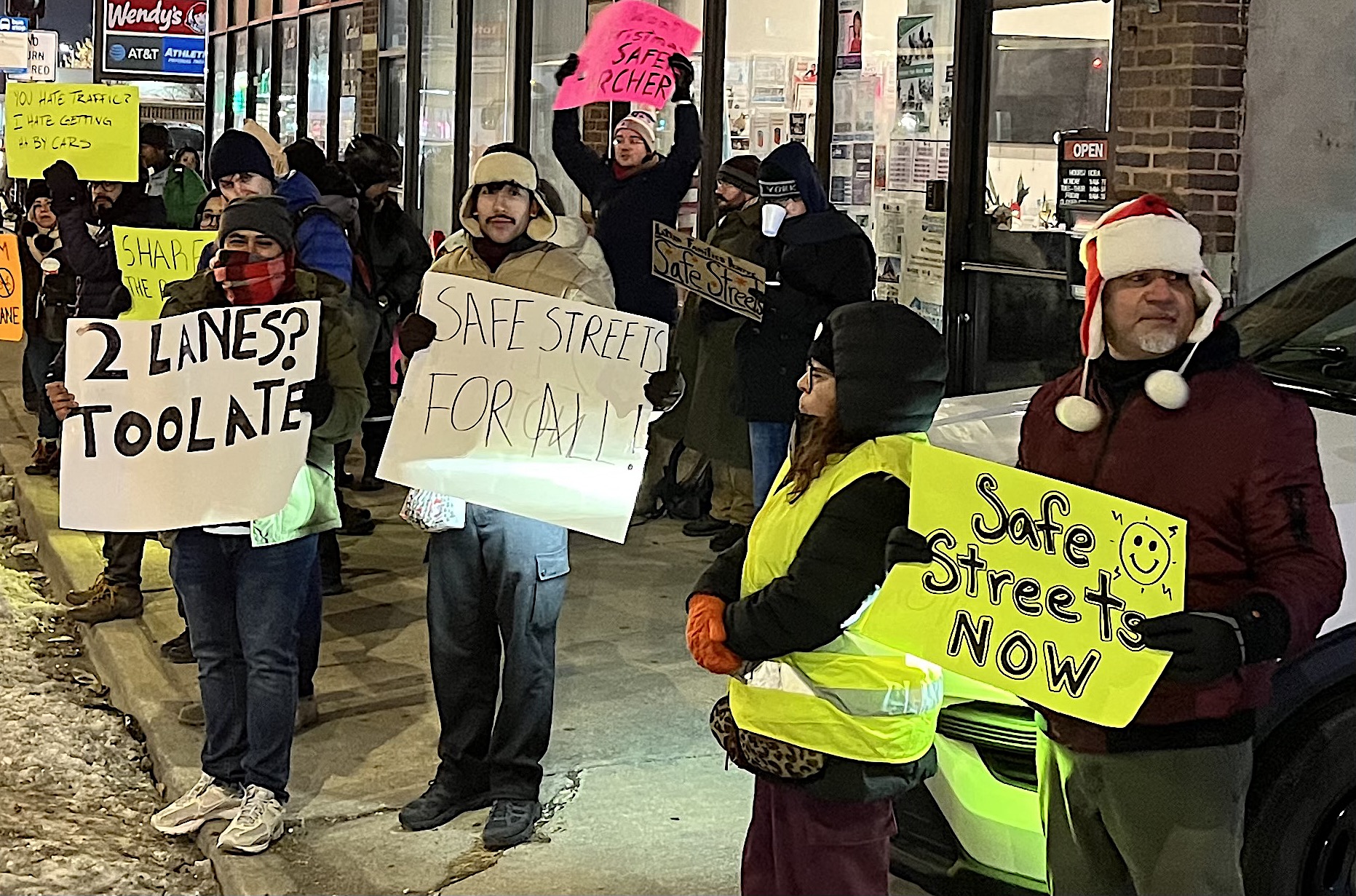At a community meeting Tuesday at Columbia College, Chicago Department of Transportation Project Director Janet Attarian outlined plans for the new Roosevelt Road streetscape from State Street to Columbus Drive. The project will include a groundbreaking new segment of sidewalk-level, two-way bicycle lane, part of a bike-friendly route to and from the lakefront. The info session, hosted by aldermen Pat Dowell (3rd) and Will Burns (4th), also covered CDOT’s proposal for a new protected bike lane on State Street from 18th Street to 26th Street in Bronzeville – we’ll have a report on that project soon.
The new sidewalk bikeway, which Attarian referred to as a "sidepath," will be built on the north side of Roosevelt between Wabash Street and Indiana Avenue, connecting with multiuse paths through Grant Park. The streetscape project will also include pedestrian improvements and high-capacity bus shelters.
Earlier this year, CDOT Commissioner Gabe Klein told Streetsblog that the department planned to install a raised lane within the next year, so it’s good to see this is coming to fruition, even if it’s only for a block-and-a-half. If this pilot is successful, it would presumably lead to longer stretches of raised lanes in the future.
As part of the streetscape, existing bike lanes on Roosevelt between State and Wabash, uncomfortably situated between bus lanes and travel lanes, will basically stay in the same configuration but will be painted green to increase visibility. At Wabash, eastbound cyclists will need to make a two-stage crossing to get to the bike lanes on the north sidewalk. CDOT would like to add special pavement markings to facilitate this move, but since Roosevelt is a state road, it may be difficult to convince the Illinois Department of Transportation to allow these, Attarian said.
Riding east in the sidewalk lane, cyclists will cross Michigan Avenue, then continue half a block on the north sidewalk to Indiana. At that point, they will turn left and head a block north through Grant Park to the existing 11th Street bike-and-pedestrian bridge. From there they'll continue southeast to the lakefront via a series of paths and tunnels under Columbus and Lake Shore Drive.
The entire route from Wabash to the lake, while bike-friendly, will be fairly circuitous. Attarian said continuing the sidewalk lanes east of Indiana on Roosevelt, which would have been more direct, would have required widening the sidewalk, which wasn't considered an option due to IDOT's car capacity requirements and structural issues with a bridge over Metra tracks west of Columbus. Rather than take the meandering new offstreet route, experienced cyclists may prefer to simply continue pedaling east in the street on Roosevelt to Columbus, where they can pick up a short path to the lakefront at the northeast corner of the intersection.
View Roosevelt sidewalk bike lanes and onstreet route in a larger map
Proposed bike-friendly, circuitous route to lakefront using sidewalk bike lanes (blue) and existing, more direct route (red).
The streetscape is very much a hybrid project, with the road configuration varying from block to block. Attarian says the new configuration on Roosevelt will better accommodate high pedestrian traffic during special events. For example, during a roughly two-hour period following a Bears game, CDOT counted some 3,000 people walking on the north sidewalk of Roosevelt near Michigan. These throngs often spill into the street, creating a hazardous situation, she said.
To make more room for wider sidewalks on Roosevelt, travel lanes between State and Michigan, currently 11 to 13 feet wide, will be narrowed to 10 to 11 feet. Between State and Wabash, CDOT will widen the sidewalks, currently 10 to 11 feet, expanding them to 15.5 feet on each side of the street. On the same block, 13-foot curbside bus/turn lanes, which get relatively high use, will be retained.
However, between Wabash and Michigan the bus/turn lanes get little traffic, so they will be eliminated to make room for expanding the north sidewalk to over 32 feet. The new space will include a 14.4-foot-sidewalk, eight feet for the two-way bike lane, and a 10-foot parkway, which will house a large bus shelter. CDOT will also add a median with trees on the east half of this block, capped by a pedestrian refuge island at Michigan.
The city is proposing to build a mid-block crosswalk between State and Wabash at the entrance to the Roosevelt ‘L’ station, but Attarian acknowledged that IDOT may frown on this. State law dictates that motorists must stop for pedestrians in crosswalks, and IDOT may fear that the new crosswalk could cause traffic back-ups. "We do feel that [the crosswalk] is really important to accommodate the pedestrian movement, but we also want to make sure that it’s a safe solution," she said. With or without a designated crosswalk, pedestrians who are currently crossing will continue to do so, but it’s good to hear CDOT is paying attention to existing desire lines.
While the new route, including the sidewalk bike lanes, could be great for ushering less confident cyclists, such as tourists on Divvy bikes, to the lake, sidepath design requires special attention to cyclists’ safety at intersections. To reduce conflicts with motorists, CDOT should install bike-specific traffic signals and make sure there is plenty of space between the marked stop bars for cars and the intersection crossings for bikes. The CDOT renderings show that these crossings will feature green pavement; perhaps LED lighting could also be embedded in the asphalt to further remind drivers of the presence of cyclists.








